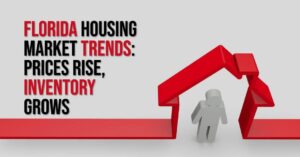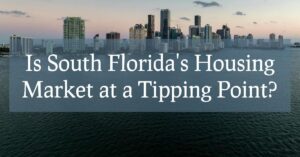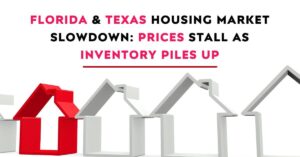The US housing market has entered a seasonal shift. The spring boom, typically characterized by a surge in home prices, has passed. In its place lies a traditionally softer period. Historically, regional housing markets on the brink of correction tend to stagnate during the spring strength, only to experience price drops later in the year.
A recent report by Parcl Labs, a real estate data and analytics firm, identified 15 housing markets most susceptible to price corrections in the coming fall and winter. While a price correction isn't guaranteed, these markets are exhibiting signs of softening, potentially giving buyers more leverage than they've had in recent years.
Intriguingly, 13 of the 15 at-risk markets are located in Florida. Let's delve deeper into the data and explore the reasons behind this trend.
Rising Inventory and Affordability Challenges in Florida
Florida's dominance on Parcl Lab's “at-risk” list isn't random. The state has witnessed a significant rise in active inventory over the past year. This upsurge can be attributed to several factors.
One contributing element is Hurricane Ian, which devastated parts of Southwest Florida in September 2022. The storm's impact continues to be felt, with lingering effects causing a further softening in the region's housing market.
Another factor impacting affordability is the sharp increase in home insurance premiums. Florida homeowners are grappling with these rising costs, further straining their ability to purchase a property.
Additionally, stricter regulations implemented after the Surfside condo collapse in 2021 have exerted downward pressure on the value of many older condos along the Florida coastline. These regulations aim to improve building safety but can also make these properties less attractive to potential buyers.
The combined effects of rising inventory, increasing insurance costs, and stricter regulations have created a complex situation in the Florida housing market.
Parcl Labs identified the following 15 housing markets as exhibiting a confluence of factors that could potentially lead to price corrections:
Supply Outpaces Demand: The most significant trend is the widening gap between supply and demand. Cities like Pensacola and North Port have seen active inventory surge by over 50% compared to last year. This significant increase coincides with a notable decline in buyer activity, with demand dropping by as much as 28% in some areas.
Price Cuts on the Rise: As sellers grapple with a shifting market dynamic, price reductions are becoming more commonplace. North Port leads the charge with over half of its listings undergoing price adjustments. Other major Florida markets like Tampa, Naples, and Palm Bay are also witnessing a substantial rise in price cuts, indicating a potential softening in home values.
Early Signs of Price Declines: The impact of this supply-demand imbalance is translating into initial price declines in 11 out of the 15 markets analyzed. Lakeland, for example, has experienced a price drop of over 4.6% compared to its peak. While not all markets are showing a downward trend yet, these early signs suggest a potential correction on the horizon.
Markets Bucking the Trend: Interestingly, four markets, including Palm Bay and Naples, seem to be defying the trend for now. These locations have managed to sustain their price gains, with no decline observed from their peak points. This suggests that certain market factors, potentially a desirable location or a strong local economy, might be mitigating the broader softening.
13 of 15 Housing Markets at a Risk of Price Correction Are in Florida
Florida:
- Crestview-Fort Walton Beach-Destin
- Deltona-Daytona Beach-Ormond Beach
- Gainesville
- Homosassa Springs
- Lakeland-Winter Haven
- Miami-Fort Lauderdale-Pompano Beach
- Naples-Marco Island
- Ocala
- Orlando-Kissimmee-Sanford
- Palm Bay-Melbourne-Titusville
- Port St. Lucie
- Sebastian-Vero Beach
- Tampa-St. Petersburg-Clearwater
South Carolina:
- Myrtle Beach-Conway-North Myrtle Beach
Alabama:
- Daphne-Fairhope-Foley.
Methodology Behind Parcl Labs' Analysis
Parcl Labs' methodology provides valuable insights into how they identified these potentially vulnerable housing markets. Here's a breakdown of their approach:
- Data Acquisition: Parcl Labs leveraged their application programming interface (API) to gather information on the 1,000 largest housing markets across the US. They excluded smaller markets with less activity, focusing only on those with at least 500 annual home sales and 500 active listings.
- Demand and Supply Trends: To identify markets with weakening demand, Parcl Labs looked for a year-over-year decline exceeding 10% in home sales over a rolling three-month period. Conversely, for supply, they looked for markets experiencing a surge in active inventory, exceeding a 20% increase year-over-year over a rolling three-month period.
- Gauging Market Distress: They also factored in signs of stress within the listing market. Markets where more than 35% of active listings underwent price reductions were considered to be exhibiting distress.
- Price Appreciation Threshold: The analysis focused on markets that had seen significant price growth since March 2020, with a minimum threshold of 50% appreciation. This ensured they weren't capturing markets already experiencing a correction.
- Excluding Existing Corrections: To avoid redundancy, Parcl Labs excluded markets where home prices had already dipped by more than 5% from their peak. This approach aimed to identify markets on the verge of a potential correction rather than those already underway.
Potential Implications for the 15 At-Risk Markets
While Parcl Labs' analysis identifies potential risks, it's important to remember that a price correction isn't guaranteed. However, these markets deserve closer scrutiny due to the combination of softening demand, rising inventory, and affordability challenges.
Here's what potential buyers and sellers in these markets might encounter:
- Buyers: Increased inventory could translate into more bargaining power for buyers. They might be able to negotiate for better deals or wait for further price reductions. However, rising interest rates could still affect affordability, so careful financial planning remains crucial.
- Sellers: The softening market might necessitate adjusting pricing strategies. Sellers may need to be more realistic in their expectations and potentially consider accepting offers below initial asking prices. The time it takes to sell a property could also increase.
For both buyers and sellers, staying informed about local market trends and consulting with a qualified real estate professional is essential for making informed decisions.
It's also worth noting that not all 13 Florida markets will be impacted equally. The severity of any potential correction will likely vary depending on the specific circumstances within each location. Local economic factors, employment trends, and the overall desirability of the area will all play a role.
Florida's Housing Market – A Look Ahead
Florida's housing market finds itself at a crossroads. The confluence of rising inventory, affordability concerns, and stricter regulations has introduced a layer of uncertainty. Parcl Labs' analysis highlights areas that could be susceptible to price corrections, particularly in the fall and winter months.
However, it's crucial to maintain perspective. A price correction doesn't necessarily translate into a housing market crash. It could simply signal a return to a more balanced market, with price growth moderating after a period of significant appreciation.
For potential buyers, this could present an opportunity to find deals they might have missed during the peak frenzy. But remember, affordability remains a key consideration. Rising interest rates can significantly impact purchasing power, so careful budgeting and a realistic assessment of financial capabilities are essential.
Sellers, on the other hand, may need to adjust their strategies. Pricing properties competitively and being open to negotiations might be necessary in this shifting landscape.
The long-term outlook for Florida's housing market depends on various factors, including the national economy and interest rate trends. While some softening is likely, Florida's underlying strengths, such as its sunny climate and diverse economy, shouldn't be discounted.
ALSO READ:
- Is the Florida Housing Market Crashing?
- Florida Housing Market 2024: Predictions for Next 5 Years
- Florida Housing Market Predictions for Next 2 Years
- Florida Housing Market: Will These 2 Metros Crash in 2025?
- When Will the Housing Market Crash in Florida?
- Florida Housing Market Trends: Rent Growth Falls Behind Nation
- Florida Housing Market Sees Record Home Prices in Northeast










